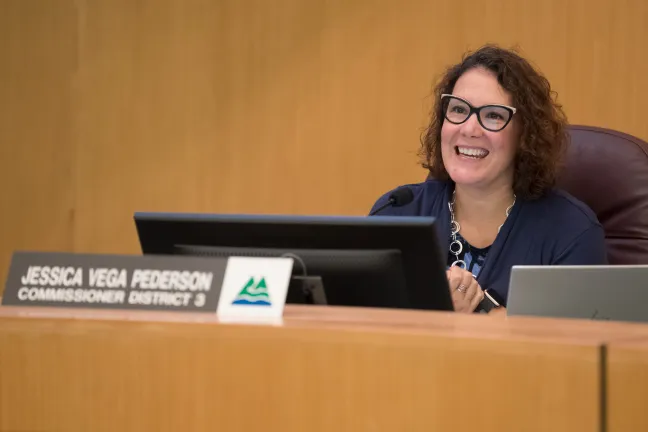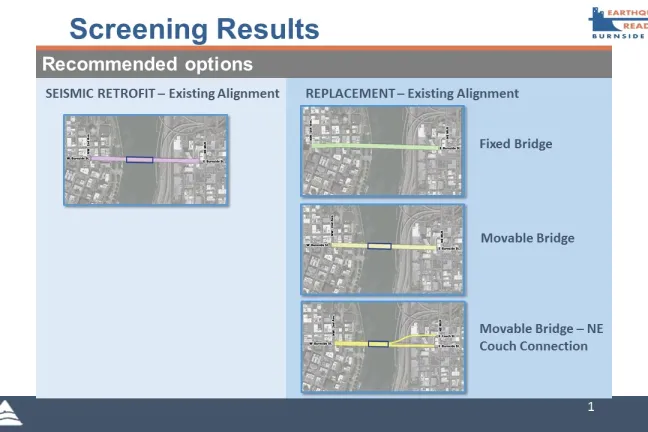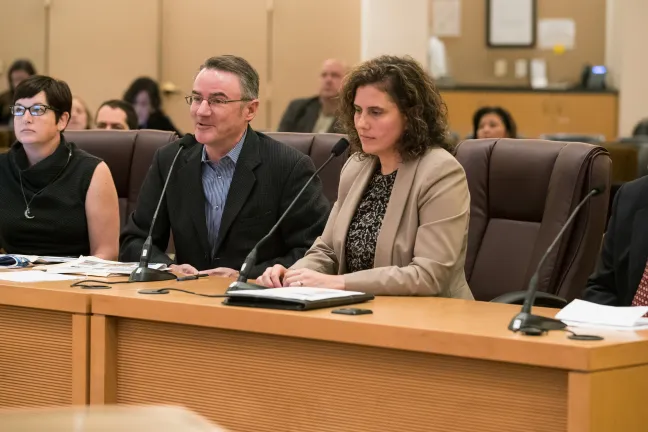On November 1 Multnomah County Commissioners moved a step closer to helping the Portland region prepare for a Cascadia Zone earthquake. The Board of County Commissioners recommended four options be studied for a Burnside Bridge crossing that can remain in operation after a major earthquake. The board also recommended a purpose and need statement for the project’s environmental review phase. The Federal Highway Administration will be asked to approve both recommendations so the project can proceed.
A team including the County’s Transportation Director Ian Cannon, project manager Megan Neill, public information officer Mike Pullen and consultant Heather Catron briefed the board on the results of a
“Compared to the other two lifeline routes that cross the Willamette River in Multnomah County, the Burnside corridor has relatively few overpasses that are expected to fail in a seismic event,” Neill explained.
Heather Catron, the project manager for consultant HDR, described the process that led to the recommendation of four build options to study in the next environmental review phase. “We screened more than 100 different options through a three-step process,” she explained. “The first screening steps eliminated options that did not meet the project’s basic tests of providing seismic resiliency and emergency response. In the third screening we evaluated options based on how they performed for seismic resiliency, non-motorized transportation, connectivity, equity, the built environment and financial stewardship.
“This process resulted in the four options we are presenting today,” Catron said. “One is an enhanced seismic retrofit of the existing bridge. The second is a new fixed bridge that would be higher to allow ships to pass underneath. The third is a new movable bridge in the same location as the current bridge. The fourth is a new movable bridge that has an extension of NE Couch for westbound traffic entering the bridge, eliminating the current tight, S-curve on NE Couch.”
The four options presented to the board have broad public support, noted public information officer Mike Pullen. The county received more than 400 public comments during the feasibility phase. “We did not hear about some fifth option that people really like,” Pullen said.
The project’s purpose and need statement focuses on creating a seismically resilient Burnside Street lifeline crossing of the Willamette River that can be fully operational after a major earthquake. The four options will be further studied based on how well they address the fundamental purpose and need for the project.
In the next two years the project team will analyze the impacts the four options would have on the natural and human environments. The analysis will be included in an environmental impact statement that will recommend a preferred alternative to build and construct.
Decisions on public infrastructure tend to be long-lasting, noted Transportation Director Ian Cannon. “The bridge is at the center of our city. It’s in an area that has tremendous affluence and some of the neediest people in our community. When we provide infrastructure, we are providing something that has a very long impact. We’re talking about a decision that will have a 100-year lifespan. We’re looking forward to a very vigorous conversation with the community about what solution they want to see.”
“Our kids, our grandchildren and great grandchildren will be really appreciative of the work you’ve done,” said Commissioner Lori Stegmann, before the vote.
“It is an incredibly complex project, and we are just at the beginning stages,” observed Commissioner Jessica Vega Pederson who co-chair’s the project Policy Group with Chair Kafoury. “I’ve been very impressed with the engagement so far, with the thoughtfulness that has gone on with stakeholders and the community. We are going to continue to work with the public to increase awareness and engagement with the project.”
“Multnomah County takes seismic threats to our region very seriously,” said County Chair Deborah Kafoury. “It is critically important that we build a lifeline bridge that can safely get emergency vehicles as well as the public from one side of the river to another after a catastrophic event.
“We have a long, long way to go before the first hammer swings to build this bridge. But the actions we take today establishing the purpose and need statement and selecting the options to study will set the county on track for a new or a substantially improved Burnside Bridge in the next decade.”



